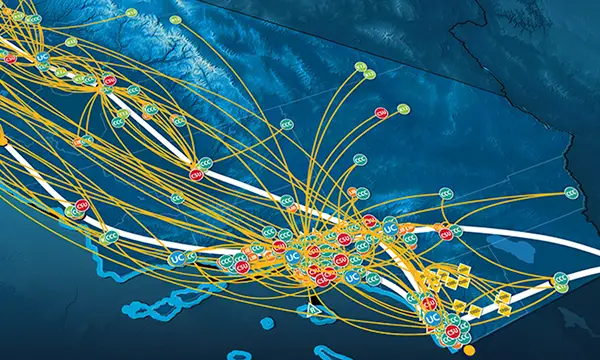- About
- Network
- Community
- Initiatives
- News
- Events
- Blog
- Publications

The California Middle Mile Broadband Initiative and CENIC: Creating a Bespoke Organization to Serve California
Categories RENS & NRENS Equity & Access GOLDENSTATENET

CENIC is well-known for its achievements designing, building, operating, and maintaining California’s leading-edge high-speed research and education network CalREN, in addition to functioning as a roundtable for networking and technology experts in California and across the globe. As a non-profit public benefit technology corporation, CENIC has been at the forefront of work to advance and expand access to its advanced network and help close the digital divide. Even as early as 2003, CENIC was promoting the mantra of “One Gigabit or Bust” for anchor institutions.
As momentum and deeper understanding of the essential role broadband plays in the daily lives of individuals, the COVID-19 pandemic exacerbated the chasm between the connected and unconnected. Advocacy efforts focused in on digital equity and access and in the fall of 2019, Governor Newsom announced his Administration would embark on a “Broadband for All” plan for the state to advance digital equity that would convene stakeholders, the private sector, educational institutions, and government agencies in building an action plan for the state.
In the spring of 2021, the Administration and Legislature unveiled an ambitious plan to invest unprecedented levels of federal and state resources into broadband motivated in part by the negative impacts the COVID-19 pandemic was having on employment, education, and health for those communities without broadband access. Ultimately, the passage of Governor Newsom’s “Broadband for All” initiative (SB 156) by the State Legislature was a historic accomplishment and infused the largest amount of resources – $6 billion – for broadband in California.
Recognizing the recent successful expansion of the CENIC network through various programs to bring connectivity to schools, libraries, rural agricultural resources sites, health care institutions, and tribes, the Legislature integrated CENIC into the final bill as the Third Party Administrator to partner with the state and create the visionary aspiration of a statewide open-access middle-mile network.
As the initiative transitioned to implementation, it was clear that its ultimate success would depend on quickly finding and enlisting the best minds to meet the complex technical, geographic, and collaborative challenges involved in creating a sustainable statewide broadband middle-mile infrastructure for all Californians.

Drawing from a Deep Bench
The CENIC team had much of the expertise already in place; however it was fully deployed with its own expansive set of initiatives, including expanding its connections with K-12 school districts and cultural institutions, while upgrading its circuits and technology in the never-ending work of staying in front of cybersecurity threats. The question was how to draw from that expertise on behalf of this new proposal while still serving its existing mission.
“It was clear we needed to launch a new entity that could serve this important initiative on behalf of California,” said CENIC President and CEO Louis Fox. “And that’s when GoldenStateNet, the CENIC California Middle Mile Broadband Initiative, LLC, was born – as a solely owned subsidiary of CENIC that could attract world-class technology professionals adept at working with a diverse array of partners and stakeholders working towards a common goal."
Fox reached deep into his extensive network of colleagues with whom he has been working for four decades, all network technology leaders capable of building collaborative relationships and all committed to the goals of the "Broadband for All" initiative.
Both the historic opportunity to serve California’s initiative, as well as to work with one another and CENIC’s talented team of engineers and technical expertise, drew more than two hundred person-years of C-suite level experience to GoldenStateNet (GSN).

CEO and COO Tony Naughtin, JD is a seasoned executive and entrepreneur with expertise in developing and executing network-based business models. “In my 32 years of internet work, the mission of making sufficient bandwidth available to as many people as possible has been on the horizon,” said Naughtin.
“It’s exciting to see the policy focus and funding come together in partnership with the California Department of Technology to make this idealistic goal a pragmatic reality. I’ve always known the importance of over-the-horizon planning to get ahead of the curve of decisions to be made from my private sector commercial experience. That level of planning has been critical to California’s two-year head start as other states begin broadband initiatives in a tight labor market.”

CIO and Senior VP of Technology Ron Hutchins, PhD has more than 20 years experience in high-performance networking and research computing for higher ed, and served as Vice Provost for Academic Technologies at the University of Virginia, overseeing UVA’s strategy and infrastructure for research computing.
“The biggest challenges are the size of the state of California and the broad diversity of both the population and the geography. It’s truly everything,” said Hutchins. “At the same time, the good part is this is a clean slate. We’re coming in with the opportunity to build a middle mile network that hasn’t been there before. And to have the team we have both within GSN and with Caltrans bringing their expertise to the table…well, it’s an amazing experience.”

Vice President for Infrastructure Erik Hunsinger has more than 25 years of experience in both commercial and non-profit telecommunications. For much of that time, he has worked and continues to work closely with CENIC to evaluate fiber optic projects that can spur broadband growth for CENIC members as well.
“I’ve always wanted to work with entities in the tech industry that demonstrated a more altruistic intent to promote access for all. That’s why I was eager to work with the team being put together for GoldenStateNet,” said Hunsinger. “After all, a lack of access to broadband is a key indicator for poor health status, poor educational status, poor job mobility - in fact, you can’t really be involved in the democratic processes of this country without access to broadband. This is a once in a lifetime opportunity to get this done right for California.”

Matt Rantanen, Vice President for Tribal Relations, brings more than 22 years of experience working with the Southern California Tribal Chairman’s Association. “I’ve been working in the intertwined worlds of networking policy, politics, and building infrastructure and have never seen an opportunity to move the needle like this project,” said Rantanen.
“This is an opportunity to erase what has been missing in the way of infrastructure that will make a difference for the 109 federally recognized Tribes in California. And with 109 Tribes plus those recognized by the state, we have nearly as many unique geographic and cultural challenges to confront.”

GSN’s public policy expertise is bolstered with the breadth and depth of experienced Government Relations consultant Rachelle Chong. “I've been working on getting broadband to all parts of California since 2006, when I served on the first Broadband Task Force set up by Governor Schwarzenegger as a CPUC Commissioner,” said Chong. “Before that, when I was an FCC Commissioner in 1994, I was impressed by then-Vice President Gore's vision of an "information superhighway" to bring the riches of a library to a child in Africa. The digital divide was something I did not want to have happen in our state. I was attracted to this position with GoldenStateNet by Louis Fox, the CENIC CEO, who reached out to me to take on the government affairs piece. I immediately knew I had to say yes, as it is a rare historic moment to have the opportunity to bring broadband to all. Affordable middle mile is a key foundation to attract last mile providers to build out to consumers homes."
All agree that there are unique strengths that GoldenStateNet brings to the middle mile work on behalf of the “Broadband for All” initiative.
“GoldenStateNet is bringing a cast of characters that are seasoned professionals both with the numbers of years of experience lending itself to wise intuition, as well as the range of jobs we’ve all done in broadband networking,” said Ron Hutchins. “It’s fun to work with people who are excited for the potential of what we’re working to accomplish. Innovations happen when you get people excited about a project that’s remarkable.”
“Our parent, CENIC, is highly respected throughout the nation and the world as a research and education network facilitating global research in critical areas like global warming, big data, and health initiatives,” said Rachelle Chong. “This is the kind of deep expertise that’s necessary to build the state’s middle-mile network in a tight timeframe, and the State Legislature recognized that.”
Tony Naughtin agreed that experience and expertise drawn from CENIC makes the difference, as well as new talent drawn to the project. “GSN has pulled together expertise with deep problem solving skills and experience which is critical to meet the cost and timing goals of this initiative. We’ve been fortunate to attract experienced talent like Tony Harris, Tori McDonald, Jim Morris, and Jack Meeks to round out our leadership team.”
“One of the great strengths CENIC brings to this initiative is a deep understanding of the commercial market,” said Hunsinger. “The development of a true public-private partnership that leverages the strengths of each will result in a resilient network that can serve the intent of this project to connect Californians to broadband and the power of those connections.”
“We’ve found that there are really good people working at the state who are streamlining processes to meet the CARES Act funding deadlines,” said Matt Rantanen. “Working together, we’re finding we can streamline things when there’s a funding deadline like this.”
A Fast Start
GoldenStateNet was able to hit the ground running once the state’s initiative launched due in large part to the significant expertise in place within CENIC that helped inform the early planning.
“We worked to convey the excitement of this initiative to seasoned innovators in networking no matter where they were so that California would benefit from both the experience and relationships each could bring to this project,” said Fox. “Of course, some of that expertise is to be found within the CENIC organization itself with people like Sana Bellamine, Brian Court, Tony Nguyen, Robert Kwon, and Stanley Han.”
GoldenStateNet also benefitted from existing administrative talent drawn from CENIC in order to launch the initiative efficiently. In the tight job market coming out of the pandemic, having resources in finance, operations, and communications in place provided a vital head start in moving the complex project forward within the tight federal funding deadlines.
The leaders of this initiative, including those serving on the GSN Advisory Board recognize the importance of the timing.
As noted by CTO Hutchins, “This is a clean slate. We’re coming in with the opportunity to build a middle-mile network that hasn’t been done before. Watching our ability to get things done is an amazing experience.”
“It is a rare historic moment to have the opportunity to bring broadband to all in California,” said Rachelle Chong.
“With strong support from the CENIC Board of Directors, and from my team at CENIC, we were able to build this focused organization, as an extension of CENIC, in a matter of weeks,” said CEO Fox. “This initiative is a natural extension of both facets of our CENIC mission: to ensure broadband equity for all Californians; and to put advanced network capacities within reach of every community in California — urban, rural, and tribal — to advance their collective goals and to ensure that every community can compete in the global economy.”

Related blog posts
The Big Game Is Big Data: How CENIC and the California Research and Education Network Support Member Athletics
When Fresno State needed to connect to Pac-12 Enterprises to broadcast a live football game over CBS, the Chancellor's Office reached out to CENIC for what Pac-12 later called the smoothest turn-up they've ever experienced.
Enabling Network-Based Collaboration Around the World: A Tour of CENIC and Partner Network Maps
On the Network Maps page at the CENIC website, you’ll find maps of all the networks, peering facilities, and exchanges to which CalREN connects, showing how thousands of CENIC member institutions connect to CalREN and to colleagues all over the globe.


